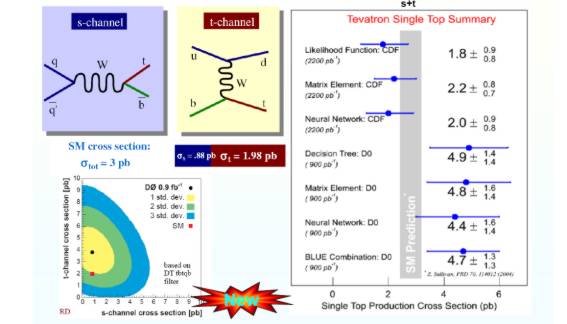
Both FNAL experiments now see the single top production (thus by weak interactions), and start to study its properties in some detail, This is also an opportunity to serach for abnormal couplings of the Top
The present document does
not aim at providing a detailed specialist account of the latest
developments
in particle physics presented and discussed in depth at the Rencontres
de Moriond.
Our purpose is rather here to
present in rather general terms some key points of the
meeting,
dealing both with the scientific content and with the specific format
which
makes the Rencontres de Moriond a unique venue.
Considerable work relating to the preparation and analysis of future
experiments was also presented,
even though space lacks to review it here.
We will thus refer the
professional
particle physicist directly to the summary talks by Ken Peach
(exp), Marcela Carena (th) and the detailed scanned
slides (or later to the proceedings)
where
the details of each presentation can be examined freely.
The illustrations below are extracted from those summary talks, where
the reference to the respective presentations can be found.
We also welcome enquiries from
information professionals: beyond the ground material found below, we
encourage
them to contact the members of the program committee (the simplest is
to
proceed via the Moriond secretariat, see at end of this file).
In the following paragraphs,
"background
" information is printed in italics.
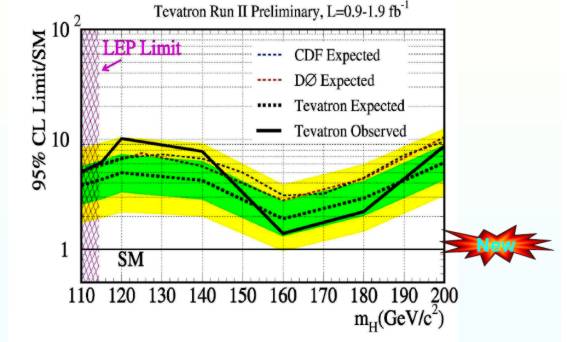
 f the scalar
structure, and generally a rather light scalar (<130 GeV), except in
the NMMS extension. Many alternate models are however currently
proposed, notably based on extra dimensions (invoking or
not a duality between strongly and weakly coupled sectors à la
AdS/CFT). In particular, in warped models (Randall-Sundrum), the
fermions and scalars can be placed according to various scenarions on
the boundaries or in the bulk. An obvious prediction is particular
flavour effects for the Top quark family.
f the scalar
structure, and generally a rather light scalar (<130 GeV), except in
the NMMS extension. Many alternate models are however currently
proposed, notably based on extra dimensions (invoking or
not a duality between strongly and weakly coupled sectors à la
AdS/CFT). In particular, in warped models (Randall-Sundrum), the
fermions and scalars can be placed according to various scenarions on
the boundaries or in the bulk. An obvious prediction is particular
flavour effects for the Top quark family.  Other possibilities (in the line discussed last year by J
Vander Bij) involve mixing the canonical scalar with other states,
possibly ending
Other possibilities (in the line discussed last year by J
Vander Bij) involve mixing the canonical scalar with other states,
possibly ending 
Bottom and Charm physics ,
Cabibbo-Kobayashi-Maskawa fits
Abundant data emerge from B factories (and Tevatron), not only on
the general oscillation/mixing parameters but also on
particular decay modes. The results are too numerous to review
here, and we send the reader to the aforementioned summary talks, or
the original presentations.
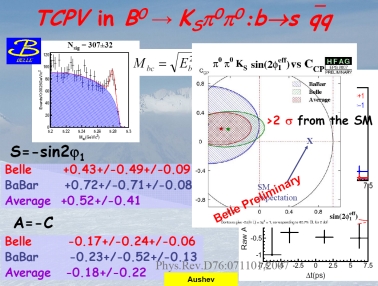 Glitches in the picture ?
Glitches in the picture ?
An intriguiing result is the measurement of time-dependant CP
violation in the Kshort Pi Pi mode for B decays. While the Standard
Model expects results similar to the usual J/Psi Kshort,
the newest data (still quite preliminary) stand at 2 sigma from that
expectation.
The summary talk also mentioned some discrepancies in the Bs decay
phases recently claimed by the UTfit team.(but too late for
presentation at this meeting)
The potential for detecting "beyond standard model", particularly in
radiative decays of B into s , is also the subject of methodical and
extensive theoretical investigation
The D° mixing has now been confirmed, and progress on CKM fits
continues .
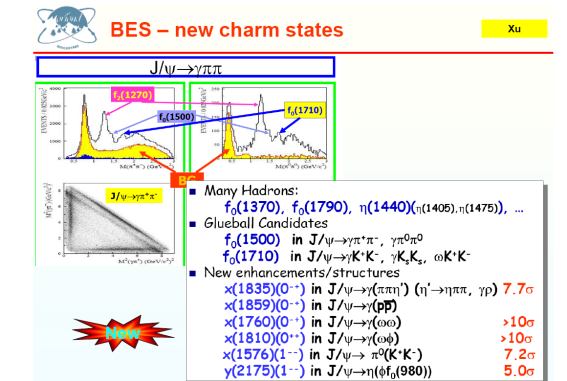 Charm physics continues to be studied in depth. We will
not review the details here, but stress an interesting development,
namely the study (at BES) of the "gluon -rich" domain of radiative
J/Psi decay ( the decay indeed can involve the intermediary
state: photon + 2 gluons ). This long-unraveled field starts to give
important results, whch will soon be ampliified with more sensitive
equipment, and are thus an area to watch in the future!
Charm physics continues to be studied in depth. We will
not review the details here, but stress an interesting development,
namely the study (at BES) of the "gluon -rich" domain of radiative
J/Psi decay ( the decay indeed can involve the intermediary
state: photon + 2 gluons ). This long-unraveled field starts to give
important results, whch will soon be ampliified with more sensitive
equipment, and are thus an area to watch in the future!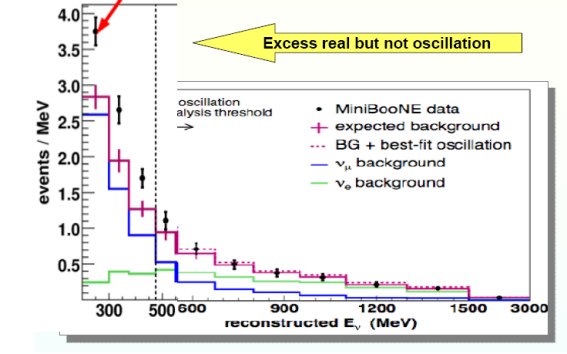 MiniBoone sparks
theoy
MiniBoone sparks
theoy 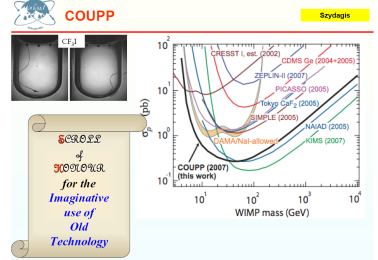 They complement the indirect searches (see above), and
the collider searches for long-lived particles.
They complement the indirect searches (see above), and
the collider searches for long-lived particles.
Cosmic rays , paticularly the very high energy
ones, could teach us a lot baout our Universe, but also about particle
physics and fundamental interactions in general.
One of the outstanding issues is the
so-called "GZK" cut-off: above some energy, the collisions of cosmic
rays (protons) with the cosmic background (relic photons) reduces
dramatically their effective range, resulting in an expected sharp
cut-off.
Another issue, particularly with very high energy cosmic rays, is their
physical origin (what are the cosmic accelerators involved), and, in an
associated way, their exact composition.
Answers to these questions are coming now,
and we are probably at a turning point in high energy cosmic rays
astronomy and astrophysice. (note that many of these questions
also arise for the neutrino telescopes, mentioned at the beginning of
this section.
Very high energy cosmic rays (and also very
high energy neutrinos) are a rare occurence, requiring the current
large instruments (from 1 to several squared kilometers) to achieve any
statistics. Even so, localizing sources remains an elusive task, since
the identification of a source by any given experiment would require
several events originiating from that direction, .. a sensitivity not
yet reached.
Meanwhile, alternate strategies are based on catalog searches. In simple
terms, this involves pooling together a number of potential sources (on
the basis of theoretical prejudice, for instance active galactic
nuclei), to associate a small area around each of the potential
sources, and to consider the total surface constituted from those
patches. If this area receives significantly more events than an
equivalent area not associated to the potential sources, a correlation
is established... This correlation establishes a link between the
observed cosmic rays and at least a subset of the considered catalog of
potential sources (or possibly other obtject closely associated).
As we will see below, it does not, at the present stage validate the
composition of the whole catalog.
For 40 years now, the Rencontres
de Moriond, initiated by a small group of physicists around Professor
Tran
Thanh Van, have brought together scientists from around the world in a
unique conference format.
The size of the meeting is voluntarily
limited,
to ensure a maximum of personal contact, and to avoid parallel
sessions:
all the presentations occur in plenary sessions, with strict
instructions
for experimenters to aim their talks at theorists and vice versa.
Considerable
time is foreseen for general discussions between the talks, and special
extended discussions are set up by the organizers as the need arises .
More important however are the private
discussions,
in particular between theorists and experimenters, where projects can
develop.
An extended break in a long working day, and the setting in a winter
sports
resort do a lot to promote a relaxed and confident atmosphere, which
facilitates
such communication.
Another striking feature is the wide age range
of participants, but here, the senior staff tends to stay in the
audience
and bring comments and suggestions while presentations are made by the
young scientists who conducted the detailed analysis. Often this is
their
first international meeting, (and for this European support plays
a crucial role) and the quality of their presentations is
impressive.
The present review is by
essence a subjective presentation of the highlights of the
Rencontres
de Moriond Electroweak2007; remarks and criticisms are welcome :
J.-M.
Frère : frere@ulb.ac.be
detailed in formation on this year's "Rencontres de Moriond" and on future related events can be obtained from:
Rencontres de Moriond :
http://moriond.in2p3.fr/